#balinese mythology
Photo
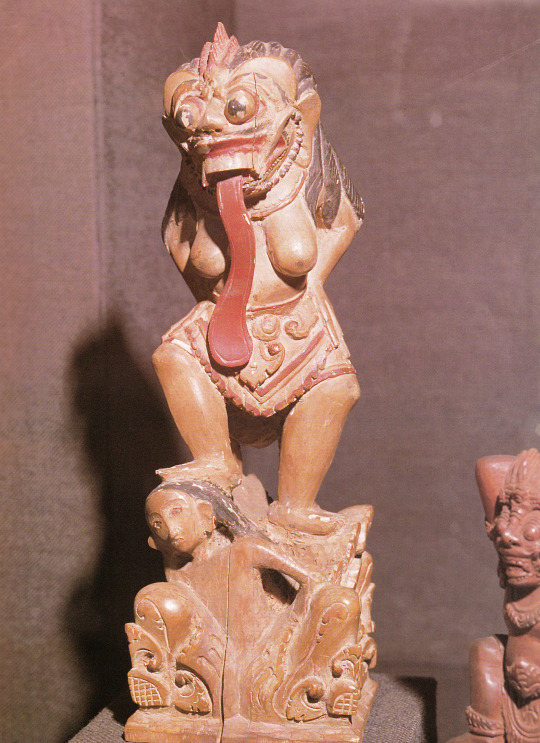
Rangda the "dreaded widow," Queen of the Witches, impersonated in the Barong dance from Bali, Indonesia (19th century).
352 notes
·
View notes
Text
youtube
Black Magic.. 🧙♀️
Cave-hiding..
Unquenchable fire.. 🔥
18 concubines.. (?)
We're going from Korea to China and Japan to Bali in this Overwatch 2 Skin Lore vid!! Discover all the stories behind the latest Asian Mythology skins here!
#overwatch 2#overwatch 2 lore#overwatch 2 skins#kiriko#ow2#amaterasu#amaterasu kiriko#hong hai er junkrat#chasa reaper#demon queen moira#chinese mythology#japanese mythology#korean mythology#balinese mythology#Youtube
17 notes
·
View notes
Text
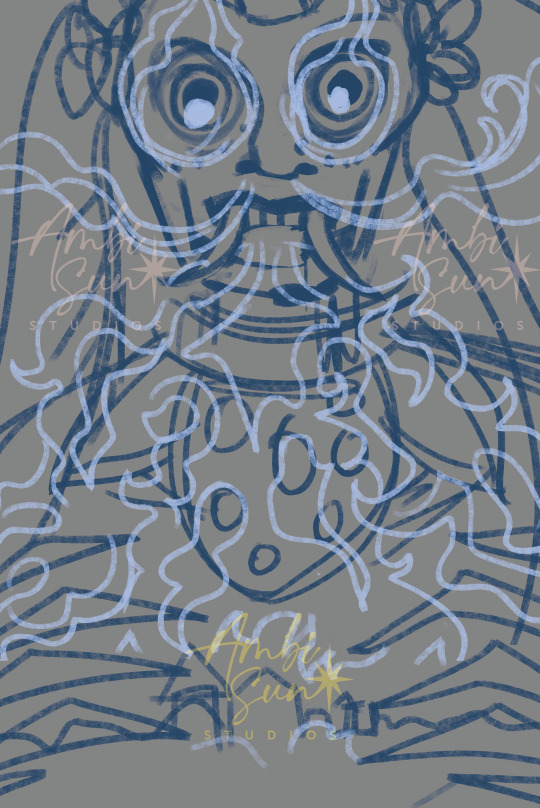


Me when learning about the story about Calon Arang. Wow she’s kinda a Karen huh 🤔 Sorry to my Indonesian friends but burning down a village because people won’t marry your daughter due to your bad behavior is pretty Karen behavior 😂
Checkout our new anthology and Oracle deck on South East Asian Folklores!
#calon arang#women’s wrongs#balinese folklores#mythology#folklore#illustration#south east asian fable#indie oracle#anthology#south east asian oracle#tales and oracle of eleven#book illustrations
11 notes
·
View notes
Text



3 notes
·
View notes
Text
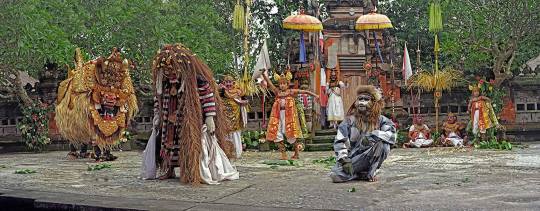
Il Barong rimane ancora oggi tra le più popolari forme di spettacolo a Bali: questo dramma rituale rappresenta tradizionalmente la lotta tra la figura bestiale benigna del Barong contro Rangda, una strega dall’aspetto terrifico, temuta per i suoi poteri di distruzione. Il Barong è una delle forme di teatro/danza balinese più rinomate e apprezzate e la sua importanza si è costituita nel tempo grazie alla sua valenza esoterica e per l’efficacia scenografica. Sebbene la danza del Barong sia descritta come uno scontro tra le forze del bene e del male, identificate rispettivamente nei due personaggi principali, Barong e Rangda, sarebbe superficiale descrivere questa rappresentazione identificando le due figure come un eroe e una antagonista. L’intera vicenda è la celebrazione attraverso la danza, la musica e il teatro dell’intero universo mitologico e religioso di Bali.

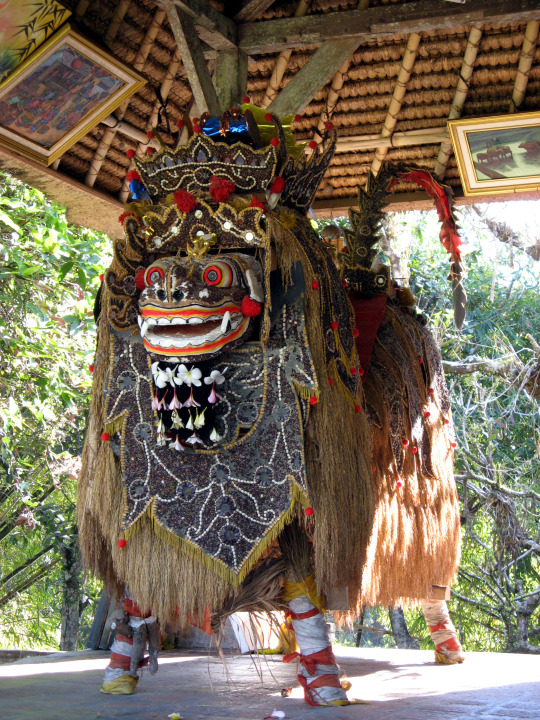
Il teatro/danza balinese non rappresenta solo un puro intrattenimento, è un mezzo per mantenere viva la narrazione del patrimonio mitologico del passato, un momento di aggregazione sociale e di condivisione che avvicina le generazioni e i diversi strati sociali all’interno della comunità. L’attore/danzatore esprime la volontà degli dei e controlla la potenza dei demoni, indirizza attraverso l’estrema consapevolezza data dal training la volontà di una narrazione, che si attua nella gestualità codificata. Le maschere di Rangda e Barong sono il simbolo della trasformazione totale dell’individualità, che si fa tramite delle forze animalesche, naturali e persino divine. Il soprannaturale si manifesta sempre nel mondo della natura, permea ogni aspetto della vita quotidiana, e nella celebrazione diviene visibile: le componenti materiali della performance, gli strumenti musicali, i costumi, le maschere e le armi vengono consacrati dal sacerdote hindu, il pemangku, come simbolo e manifestazione del potere divino.



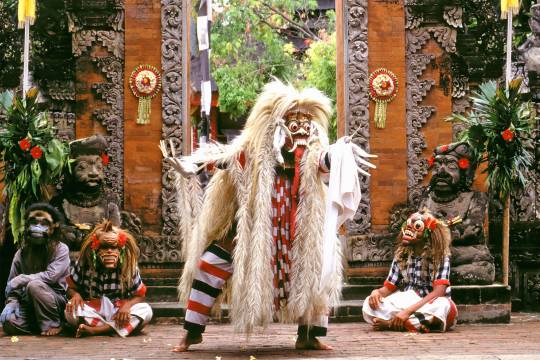
Rangda incarna nella sua funzione mitologica la potenza distruttiva delle forze demoniache, è collegata alla dimensione ctonia, e tutti i suoi attributi aggressivi e terrifici richiamano le sue grandi capacità magiche e la sua volontà divoratrice, che può essere canalizzata e controllata attraverso lo scontro rituale. Il suo legame con Durga, la dea hindu, è una chiave di lettura fondamentale per comprendere quanto l’aspetto del divino sia inevitabilmente soggetto ad esercitare in maniera ciclica il proprio influsso distruttivo sul mondo, oscillando alternativamente tra creazione e caos.


Le maschere e i costumi del Barong possono essere molteplici nella scelta della forma animale. Può somigliare al leone (barong ket), ad una tigre (barong macan), ad un cinghiale, ad un cervo o assumere una forma antropomorfa. Il termine barong sembra derivare dalla terminologia barwang, di provenienza sanscrita che letteralmente significa «orso», secondo l’origine in un antico poema giavanese. La sacralità della maschera del Barong non deriva dalla scena, è venerata come portatrice di una spiritualità propria. Il Barong è la forza divina che può contrastare con il suo potere la terrificante presenza di Rangda dagli occhi fiammeggianti, divoratrice di uomini e sacerdotessa di magia nera.
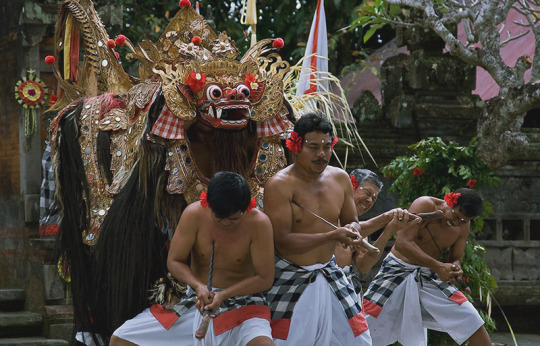
Secondo la visione balinese, non è possibile eliminare definitivamente il male dall’esistenza, confinandolo nella sua originaria sede lontano dagli uomini: le forze demoniache, portatrici di calamità, malattie e distruzione necessitano di essere debitamente considerate, riconoscendo la loro esistenza e potenza, in casi più estremi controllando attivamente il loro influsso. È fondamentale provvedere costantemente ad un bilanciamento tra le forze divine e quelle demoniache: esse esistono entrambe all’interno della dimensione umana ed esercitano il proprio potere sull’interiorità di ciascun individuo. Anche gli dei stessi, secondo la mitologia del retaggio induista, sono costantemente in bilico tra impulsi creativi e distruttivi, mostrano un volto benigno e uno terrifico e sono soggetti ad un equilibrio dinamico. Grazie alla danza, al teatro e alla musica è possibile esercitare un influsso per bilanciare il divino e il demoniaco.
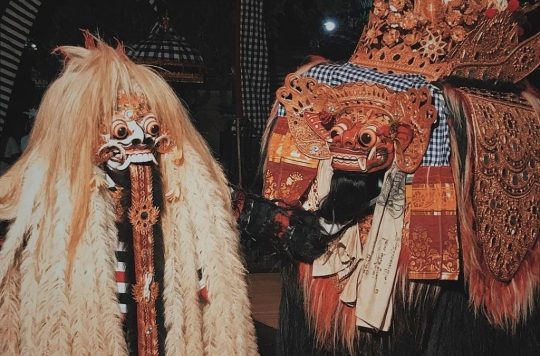
"Le maschere di Barong e Rangda nel teatro balinese"
Articolo scritto da Giulia Sala e pubblicato sulla rivista online di antropologia culturale, etnografia e sociologia La Rivista Culturale, il 21 novembre 2021
#barong#rangda#bali#balinese#mythology#dance#myth#mask#ritual#mitologia#mito#rituale#maschere#danza#teatro#theatre#culture#cultura
0 notes
Text
Barong - Day 25
Race: Avatar
Alignment: Light-Neutral
April 24th, 2024

I'd like to start this daily demon spotlight with an admittance of bias. Barong is my favorite demon in the series, bar none. In celebration of making it to 25 (!!) days of this series, I've decided to let the holy cat out of the bag. Barong is the demon that introduced me to Balinese mythology, has saved my hide several times throughout the series, and has an adorable and unique design to boot. He stands right next to, if not above Black Frost and Chernobog in my book. Past that, though, I would also like to say- thank you all for sticking with me for 25 days! It's been so damn fun, and I plan on continuing this series for months, if not years to come. I know it's a little early for the ivories, but the small community that has been built up over time has given me so much life and energy!
With that sappy stuff out of the way...
Today's demon of the day lies in the form of the great panther, protector of mankind, and host of all things good, Barong. Bali mythology is surprisingly easy to look through, having solid roots and foundations, as well as its origin being in a somewhat small subset of Indonesia, though this isn't to say it's not complex. Balinese mythology takes a unique form, one similar to the worship of Ame-no-Uzume, wherein several of its stories aren't plays nor grand tales, but rather, fascinatingly hypnotic dances. Barong's appearance in these dances is that of a glamorously decorated (and very ambiguous) animal that I would personally say looks somewhat, vaguely similar to a lion?

However, the type of animal it is isn't that important, and admittedly just makes me confused. What is important is Barong's role in Balinese mythology, that being of a protector of humanity itself- in the mythos surrounding Barong and its eternal rival Rangda, Barong represents good health, good fortune, and has reign over all the spirits that inhabit the small province. The most prominent myth featuring the great avatar is recanted in the famous Kris dance, a dance representing Barong battling with Rangda. During the hypnotic trawl, dancers bring swords dangerously close to hurting themselves, though they emerge unscathed, watched over by two dancers in an ornate harness holding up the avatar of Barong who dances furiously behind them.
The dance begins with two monkeys and Barong engaging in dance, though quickly escalates as witches sent by Rangda attack the frolicking group. The dance-drama escalates from there as Barong tries to reign back control over the kingdom, which had found itself under siege by Rangda, eventually leading to the most iconic scene of the play, wherein two palace guards stab themselves with kali daggers in a desperate trance under Rangda's control- though they emerge unscathed as Barong comes to the rescue and engages in battle with the witch, protecting the guards with his holy magic. After a long and fraught dance between Barong and its rival, eventually, the holy avatar emerges victorious, and the kingdom is returned to peace and prosperity.
Barong is not just an artefact of the dance, though- he's an important figure in Balinese tradition, one held in reverence and good spirits, and the dance is simply held to represent the eternal struggle between good and evil, as well as celebrate the triumph of the love and goodness that Barong represents. People equipped in Barong costumes even, on occasion, parade around Balinese towns in order to ward off evil spirits and bad luck. Barong is locked in a never-ending battle against Rangda and the forces of darkness, yet never gives up hope; As a Bali volunteer in the Bali Volunteer Program puts it, "Once the trance is over, Barong and his supporters finally overthrow Rangda. But she does not die. Instead, she reincarnates and Barong must defeat her again. The fight never stops. It is symbolic of light’s eternal strife against darkness."
In the SMT series, Barong is depicted faithfully, though far more blue than red. Decorated in jewels and studded in silver, the Balinese lion dances in combat, easily connecting to the dance-dramas the beast is so frequently depicted in. Interestingly, a common series staple is that of Rangda and Barong's fusion leading to Shiva, and while unconfirmed, I have an idea as to why this may be the case. While Barong and Rangda are from completely different mythologies, they both represent opposing forces of light and dark, something that Shiva, a god of destruction who is not evil, is an inherent blend of- Shiva is both light and dark, good and evil, while Barong is good, light, and Rangda is evil, dark.
All in all, Balinese myth's hypnotic dances and beautiful performances lend to an amazingly designed demon that truly fulfills all it sets out to do, represents an underrepresented mythology, and stands out as my personal favorite demon in the series. Next to Chernobog and Black Frost, of course. And also Parvati. And Mother Harlot. Am I just edgy?
#shin megami tensei#smt#megaten#persona#daily#smt nocturne#barong#bali#baliindonesia#balinese#hehe funny doggy..#the dances that i talk about in this dds are really fascinating to look at#i didn't put any pictures of the dances themselves due to how most depictions are#very similar in appearance to self harm?#but if you can stomach it they are fascinating#self harm mention#tw sh related
11 notes
·
View notes
Text
flower/plant in dramas
Prompted by the conversation I had with @colourme-feral about plumeria and jasmine being featured in the first episode of I Feel You Linger in the Air (and also, plumeria was featured in KinnPorsche during the scene with Khun Spikes our beloved), I was tempted to write this post. Honestly, I always love to see how flowers or plants or even parks (not theme-parks) are used in dramas. Flowers and plants give visual localities and in many cases it's a part of natural and cultural elements of a place where the drama is set. And for me, it is always interesting to see how people 'place' their priority on parks, or to some extent, forests, through a piece of media; are they treated just as a side / decorative elements (as an escapade, or simply a break, destination, maybe), or as center stages? (Sorry, I was once an architecture/landscape architecture graduate and still, until today, have this default interest towards these living elements -- tropical flowers and forests my beloved! --, and since I LOVE watching my Asian shows, how they were presented there - will I always write about them, though, that's another case.) So, I am thinking of making some posts about flowers in dramas (specifically in Thai dramas). As I focused more on the Southeast Asian context, I might miss some facts about of the flower(s) from the perspective of other regions, but hopefully I didn't leave out anything significant.
part 1 - plumeria/frangipani
Plumeria (or also popular as frangipani) is a genus of flowering plants native to the Neotropical areas (including Mexico, Central America, the Caribbean, Brazil, and Florida in the US) but had been spread throughout the warm tropical regions as ornamentals. I'm not going to list its different types of species but given that Plumeria is known more as a common name, here's a list of how the flower is also called across Southeast Asia's region: Frangipani, Cempaka, Kemboja, Bunga kubur (Malaysia); Kamboja (Indonesia); Kalachuchi, Kalasutsing-puti, Kalasutsing pula (the Philippines); Lan-thom-khaao, Lam-thom-daeng, Lee-laao-dee (Thailand); and Dai (Vietnam). Please feel free to correct me if you see any of these names to be wrong.
There's no clear evidence on how and when exactly the plants came to Southeast Asia, however, two temples in Indonesia (one built in the 9th century and the other in the 14th century before the European came to the region) had the flower trees depicted in their relief.
In Southeast Asia, both the flower and the trees of Plumeria are considered sacred. The flower is strongly associated with religion and temple life in both Hindu and Buddhist cultures, for examples, it is used by the Balinese Hindus in their temple offerings.
The Plumeria is also linked to ghosts and graveyards in the Philippines, Indonesia, and Malaysia where the trees are often planted at cemeteries both to give shading and to function as signage. Bunga kubur, one of the known names of Plumeria in Malaysia, literally means cemetery/graveyard (=kubur, or kuburan in Indonesian) flower (=bunga). Locals believe that the flowers give shelter to ghosts and spirits. In Malaysian-Indonesian folklores specifically, the flower's fragrance is even associated with a certain type of mythological creature that is a vampiric spirit (who likes to hang out on the trees), thus the flower often perceived as bad luck.
However, on the other side, Plumerias are also commonly used as ornamental plants in houses, parks, parking lots, and other open area as part of the elements of modern landscaping.
This interesting article compiles five interpretations of Plumeria flower meaning across various cultures, those are: (1) Peace, joy, and warm welcomes; (2) Openness to new relationships or loyalty to existing ones; (3) Ties to death and immortality; (4) Fertility, rebirth, and femininity; and (5) Medicinal healing powers.
The article above, with additional information taken from here, said that in Thailand, the way they would say Plumeria (ลั่นทม / lân-tom) was similar to the word for 'sorrow', or 'gloomy, sad, and depressed' (ระทม / rá-tom). This might be why the flower had a negative meaning to the people or community in the past and considered an unlucky plant. However, this perspective is changing and now Plumeria (or Frangipani) has a new name that is ลีลาวดี / Lii-laa-wá-dii/Lee-laao-dee.
Lastly, here's another article that talks more about Kalachuchi (another name for Plumeria) flower.
the flower in dramas:
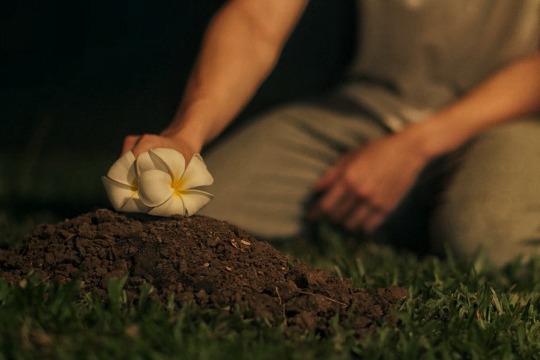
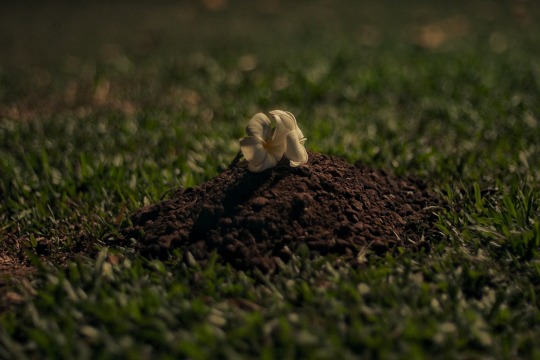
KinnPorsche -- Remember our Khun Spike. Plumeria flowers here were used as offering or signage on top of the grave.

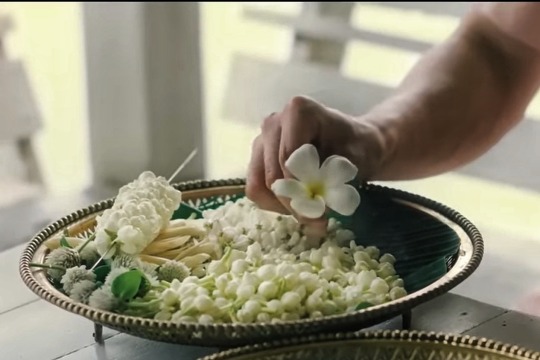
I Feel You Linger in the Air -- A Plumeria flower here was used as a prop, depicted falling from the sky onto the top of a plate of jasmines. It might hold some symbolisms: a welcome, an openness, or transfer of 'spirit' or soul across the time dimension.
Next, I plan to write about jasmine (Part 2) and hibiscus (Part 3).
Sources: [1] [2] [3] [4] [5] [6] [7] and the book "A Field Guide to Tropical Plants of Asia" by Engel & Phummai, 2008.
#flower in dramas#flowers#tropical flowers#plumeria#frangipani#i feel you linger in the air#kinnporsche#i'm tagging the shows for organization purpose#*this is why i don't write much here it took me so long to compile things i wanted to say :')
38 notes
·
View notes
Text
Guess who the fuck is getting distracted!
Me. I am getting very distracted.
Okay now if you are still here listen to my rant.
*screeching like a fucking pterodactyl* LISTEN TO ME!
I have a new WIP idea *laughing through tears*.
So I am going to call it 'Mortal Gods'. It is going to take place in a futuristic world where old beliefs of gods and pantheons still exist. People still follow old rituals and everything. However all this god shit is real. Of course nobody ever sees the gods nowadays...it's just the demons circling the cities.
So the story takes place after 'the great end' failed. 'The great end" was Ragnarök, Kali Yuga, Frashokereti, Armageddon, the aztec's last sun, etc. In short all the prophesized end of the world events in diff mythologies started coming true. To stop this the gods from different pantheons exiled the gods who were the cause of these things more or less. In addition to that they also exiled gods who are associated with destruction, chaos and evil. So ragnarok failed.
A couple thousand years later cities were rebuilt but demons ran rampant everywhere. So each city has like a shield surrounding it (kinda like the wall in Nimona). Also teleportation devices exist in this world because that's how people travel outside their cities. That or get attacked by a million demons.
The gods see that the number of demons around the world is increasing and they realize that they have made a big fucking mistake banishing all the gods of destruction and stuff. They kinda destroyed the balance, ying and yang. So they pull out the souls of the exiled gods from the fucking void that they put them in and stuff them into mortals. Then they start a competition. Only five of these gods get to go back to immortality. The rest will be wiped out of existence along with their mortal hosts. The ones who win will get to decide what to do with their mortal hosts.
So the characters will have like two personalities. One belongs to the god they are hosting and the other is their own. The longer they host the god the more crazy they become. Also if they god uses too much power they risk obliterating the mortal body and loosing the competition.
Of course there will be a time limit and a bunch of killing. To see who is the last five standing.
Also the demons and god's powers are restricted to their domain. Domain being the place where their mythology exists. Balinese demons and gods will loose more of their power as they travel further away from the centre of Indonesia (the capital city, Jakarta). Character from Russian folklore will loose their powers the further they get from Moscow. And so on.
I know that a country's mythology changes from region to region but I needed a centralized area to concentrate their power on. Or else mythologies from bigger countries/areas will have more power.
So yeah that is my new WIP.
19 notes
·
View notes
Text
Welcome back to my series discussing the real-life inspirations for all legendary and mythical Pokémon. Today I’ll be covering gen II. For previous entries see gen I, all starters, all fish, and all non-fish aquatics.
The legendary beasts were a first in in the series for being legendary Pokémon that are actually the subject of legend. They were three Pokémon who were killed in the brass tower burned down, but were then resurrected by Ho-Oh. Each one represents one of the events involved in the burning of the tower. I personally like the theory that they were the gen I eeveeloutions before being revived. While the beasts are very cool, I don’t know if I can forgive them for introducing the roaming legendaries mechanic to the game. I’m going to hold off on covering the paradox beasts for now because I haven’t decided if I’m going to cover the paradox Pokémon at all and we haven’t seen paradox Entei yet.
Raikou is electric type and represents the lightning that struck the brass tower and started the fire. It’s also definitely the least utilized of the beasts. Entei gets a movie and Suicune gets to be a cover legendary but poor Raikou gets left behind. Anyway, it’s based on the raijū, a creature from Shinto mythology. The Raijū is the companion of Raijin, the god of thunderstorms. It is normally calm and peaceful, but during storms it will fly around as a ball of lightning and its roars sound like thunder. It is normally depicted as a dog or wolf, but can also be depicted as a huge variety of animals and mythical creatures. That’s pretty much a dead ringer for Raikou, but there’s still more. Raikou may also draw form the Nue, a chimera from Japanese mythology that is usually described as at least part tiger and can transform into a cloud and go flying around. In terms of real-life inspirations, Raikou is also based on Smilodon, the most famous genus of saber-toothed cats. These are commonly called saber-toothed tigers, which fits with Raikou being yellow (which is kind of like orange) with black stripes. Raikou’s shiny also makes it look more tiger-like.
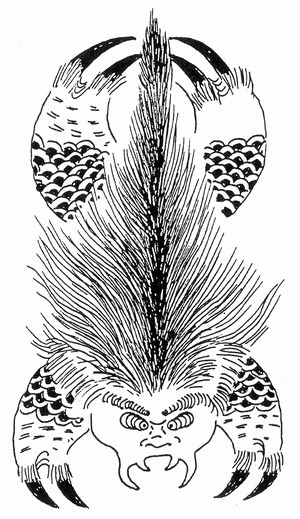
(image: a depiction of a raijū as an abstract beast not clearly resembling any real animal. The source given fro this image was Ban Koko's Kanda-Jihitsu but when I looked that up the only references I could find to that work were the citations attached to this image)

(image: paleoart of a Smilodon depicting it as a large, thick-bodied cat with a short tail, brownish coat covered in spots, and protruding fangs from its mouth. Source)
Entei is fire type and represents the fire that burned down the brass tower. It looks like a combination short-muzzled dog and big cat and is based heavily on Barong, a heroic panther spirit from Balinese mythology. Barong is the leader of the forces of good who battles the demon queen Rangda in a struggle between good and evil. Entei’s shagginess around the head and neck resembles a lion’s mane and lions are associated with strength in many cultures. There is also a connection between lions and fire as in alchemy, a lion is used as a symbol representing the sun. Dogs also feature in Entei’s character design, especially saint bernards, who are large, strong, and shaggy dogs with shorter muzzles. Entei’s design is meant to look like an erupting volcano, with its fur being the base of the volcano, the plates on its back being rock broken open, the smoke emerging from its back being smoke, and its red and yellow facial markings being lava.
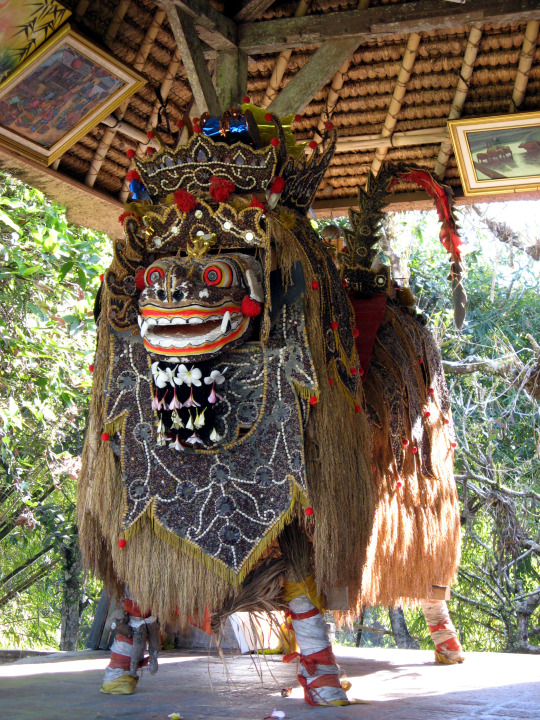
(image: a Balinese statue or effigy of Barong, depicting it as a large quadruped covered in shaggy fur with a cat-like face and decorated with a crown and jewlery)
Suicune is water type and represents the rain that extinguished the brass tower’s fire. It’s the hardest one to pin down a relationship to a real animal, but the designer said it was designed with leopards in mind. The leopard design plus Suicune’s connection to the north wind references Fūjin, the Shinto god of the wind, who wears a leopard skin. Fūjin and Raijin are commonly seen together, giving a close relationship between Suicune and Raikou. Suicune’s mane looks like an aurora and its ribbon-like tails move in a way that seems like waves or gusts of wind. Mythologically, Suicune draws from the qilin, a mythical Chinese creature. Descriptions of the qilin vary, but they are always depicted as ungulates (hooved animals) and in many stories can walk on top of water like Suicune. Chinese qilins are usually depicted as draconic and may have one or two horns. Suicune splits the difference by having two horns that fuse together. The Japanese version of the qilin, the kirin, is usually depicted as more deer-like, which more closely fits the clearly mammalian Suicune.
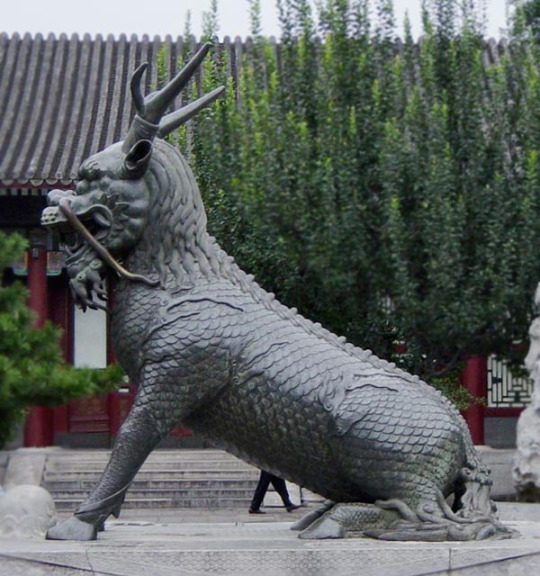
(image: a stature of a qilin at the Summer Palace in Beijing. It depicted as a quadruped with a horde-like body plan and hooves, but reptilian scales. its head looks cat-like, with a beard, long barbels from the snout, and small antlers)
The tower duo started the trend of having version-exclusive legendaries on the box art of the games. Despite this, legendarries being important to the plot wasn’t a thing until gen III, therefore the tower duo don’t have as much attention and lore as the box art legendaries that would follow. In theory they are both birds and their name comes from how they used to roost on top of the bell tower and brass tower until the brass tower burned down, causing them to leave. They are also both related to a legendary trio, with Ho-Oh being the creator of the legendary beasts and Lugia being made into a mediator for the legendary birds by the 2nd movie.
Lugia is one of the most iconic legendary Pokémon as well as one of the weirdest. It is really hard to pin down what this thing is supposed to be. Lugia is the guardian of the sea and is associated with storms and the color silver. While it normally lives underwater, Lugia can breathe air as and fly. It is notoriously classified as a flying type and not a water type. Lugia really should be water/flying instead of psychic/flying. Lugia was designed for the 2nd movie and the designer was surprised to find out it got added to the games as well. What exactly Lugia is is a hard question to answer. It looks a bit like a short-necked plesiosaur or a penguin, which fits it being aquatic. Its name and color might come from beluga whales. Another possible source is Bahamut, a gigantic, monstrous fish from pre-Islamic Arabian mythology that was one of multiple creatures that carried around the world. An older name for Bahamut is Lutīyā, which certainly sounds like Lugia. Lugia looks vaguely draconic and may be based on Ryūjin, the Shinto sea god who was a dragon that lived at the bottom of the sea.
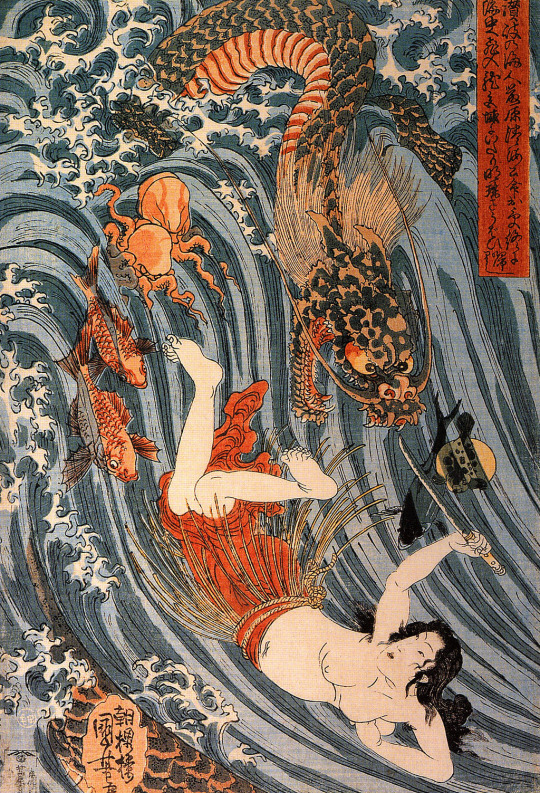
(image: the painting Princess Tamatori Steals Ryujin's Jewels by Utagawa Kuniyoshi. Ryujin is depicted as a serpentine, wingless dragon emerging from a wave)
Together with Ho-Oh, Lugia represent duality, which is frequently symbolized as a dragon and a phoenix. The dragon represents masculinity and yang while the phoenix represents femininity and yin.
As mentioned above, the theme of duality represented by the dragon and the phoenix inspired the tower duo. Lugia is the dragon while Ho-Oh is the phoenix. Or rather, it is the fenghuang, the immortal bird of Chinese legend that often gets translated to English as “phoenix”. The Japanese name for the fenghuang is hōō, which is pronounced the same as Ho-Oh. Both are said to have many colored feathers like Ho-Oh. While the fenghuang is sometimes associated with fire, the fire and immortality aspect of Ho-Oh seem to come from the western phoenix, famous for rising from its own ashes after death. Ho-Oh likely does this too as the Sacred Ashes item is apparently Ho-Oh’s ashes and can restore your party members from fainting. Pheonixes are often used to symbolize immortality and rebirth, which fits with Ho-Oh raising the legendary beasts from the dead. Other possible inspirations include the Slavic firebird or the three-legged crow.

(image: a statue of a fenghuang from Nanning, China. It depicts a perched bird with a long neck and head crest pointing backwards. Its tail is that of a peacock's)
If Celebi had debuted after gen 6, it definitely would have been a fairy type because it is heavily based on fairies, nature spirits, and other mythical creatures. Celebi is based on nature spirits like the Greek dryads and Japanese kodama, but primarily the idea of kami. In the Japanese religion of Shinto, every object has an associated spirit or god called a kami that embodies that object. Celebi being a forest spirit and being found in a Shinto shrine clearly indicates that it is a kami if the forest, presumably Ilex Forest as that’s where its shrine is found. Celebi’s time traveling ability is likely a refence to fairy stores where someone will visit the land of the fairies for a little while, only to find out that years if not decades or centuries have passed in the brief time they were there. Or they may spend years there to find only minutes have passed back on Earth. Celebi’s physical appearance is a fairy mixed with a plant bulb. It’s worth noting that Celebi’s beta design clearly drew form Kokopelli,a god of trickery, fertility, and music worshipped amongst some Native American tribes of the southwest US. A depiction of Kokopelli has become a common symbol in the southwest US.


(images: left: three beta sprites for Celebi, with the first being an all-black silhouette of a cartoonish humanoid blowing a flute with long appeandages emerging from the back of the head, the second being a similar creature with short limbs and no flute now colored mostly orange, and the third being almost identical to the finished Celebi design. Right: the common modern depiction of Kokopelli, an all-black humanoid silhouette blowing a flute with multiple appeandages emerging from the back of the head.)
#pokemon#johto#legendary beasts#tower duo#raikou#entei#suicune#lugia#ho oh#celebi#raiju#nue#barong#qilin#kirin#fujin#ryujin#fenghuang#phoenix#kami#fairy#kokopelli#japanese mythology#shinto#chinese mythology#balinese mythology#legendary pokemon#mythical pokemon
16 notes
·
View notes
Note
Sevcon's outfit sorta makes me think they're a dryad? though I might be wrong since at first glance I thought their clothes were made from plant material
I can see where you're coming from her green gown but she's no Dyrad or plant based creature! Her gown looks like that because when she's underwater, she creates more circles (the orbs that circle around her head) to spiral around her gown which creates this look that she has a mermaid tail!

The circles are the ones helping her swim like little turbines. There's also a reason why her gown (or just overall clothes) are the because she's supposed to be a nod to Nyi Roror Kidul.
Nyi Roro Kidul is a supernatural being, named as the Queen of the Southern Sea. If you look up illustrations and overall depictions of her, she's always wearing green. It's her sacred color! I'm very interested with her tale and there's also a superstition in Indonesia in which you should not wear green whenever you're out swimming because then you'll anger Nyi Roro Kidul and misfortune will be brought upon you.
But overall her tale is interesting and I do suggest you look up her legend.
Besides that, there were also lots of references I used for the other levels;

If Termination Shock and Cascade's outfits remind you of something then you're right on the money! Termination Shock is Dutch and I referenced some uniforms (Dutch East India Company soldiers) while Cascade I referenced from that one painting of Napoleon.

Besides that, my personal favorites have to be the beasts because their faces and overall shapes are a nod to the illustrations of animal-like beings (and sometimes even humans!) With their bulging eyes and exaggerated mouths (gums and teeth). More or so, Wayang Kulit.
The Art Of War is obviously a nod towards dragons, specifically those dragon statues in Bali relating to the folklore of the Red Dragons. Should note that whenever I say dragons, I'm not talking about the winged ones, no, I'm talking about the ones that swim. Sea serpents kind of deal.
Dubwoofer Substep is also inspired by the Barong, part of Balinese Mythology. The king of spirits, leader of hosts of good, and an enemy of the Demon Queen; Rangda. The Barong Dance tells the story of Barong and Rangda, an eternal battle between good and evil. I highly suggest looking it up along with the Barong costume!!!
66 notes
·
View notes
Text
Mystic Manor at Hong Kong Disneyland: The Ultimate Guide
why does mystic manor have no ghosts?
- in chinese culture, people typically see ghosts as their ancestors so it would be considered quite disrespectful and weird if disney decided to place a haunted mansion with ghosts there
what year is mystic manor canonically set in?
- the actual manor was built in 1896 but the museum was not completed until 1909 or 1910. this is the same time when lord henry acquired the balinese music box
if there are no ghosts in mystic manor, what drives the storyline?
- part of mystic manor’s story heavily relies on both historical and mythological allusions including references to key historical and mythological figures throughout the attraction including hercules (in the form of a greek amphora), medusa (in the form of a mosaic) , striborg, the slavic god of winter (in the form of a painting), the tragedy of ragnarok (in the form of a vanity mirror), ra and ihy, the egyptian gods of the sun and music (in the form of clay tablets), and the monkey king from chinese mythology (in the form of a carved statue)
- references to 18th, 19th and 20th century royalty can also be found through both objects and names. both lord henry and albert’s names are references to two sons of king george v; prince henry, duke of gloucester and prince albert, duke of york (later king george vi) to which their father ascended the throne at the same time lord henry found the balinese music box (circa 1910)
- additionally, there are also references to the french and russian royal families in the form of a vanity fan depicting king louis xvi and marie antoinette within the queue’s display case and a violin belonging to tsar alexander i inside the russian room of the explorers club restaurant
what architectural style is the manor?
- creatively dubbed, “tropical victorian eclectic”, the manor’s architectural style is based on traditional victorian queen anne architecture, as well as gothic revival and second empire but also includes other architectural elements from different countries such as traditional chinese and muscovite russian
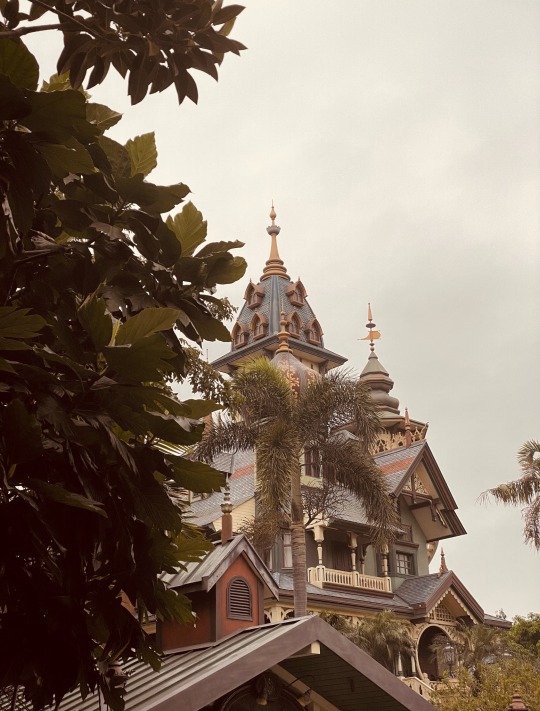
#haunted mansion#mystic manor#society of explorers and adventures#hong kong disneyland#disney parks#s.e.a
1 note
·
View note
Photo
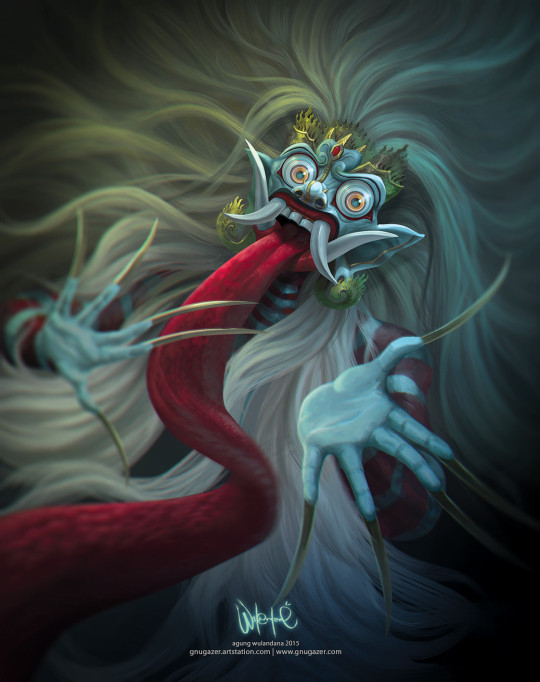
The Leyak [Indonesian/Balinese mythology]
In Balinese mythology, there are tales of the Leyak, Leak or Leya. These creatures also appear in myths from other Indonesian places and some surrounding countries and are a counterpart of the Thai Krasue spirits. They most commonly appear as floating heads, usually stylized with large fangs and adornments, and also with a very long tongue. Usually, there are organs still attached to the head, dangling below it.
They were once human, but they practiced black magic and transformed themselves into these creatures. During the day, they take on a normal human form and are indistinguishable from regular people. In some versions, a Leyak can transform into an animal like a fly or a pig (I wonder why those specific animals?).
These witches eat the souls of newly born babies, and will therefore seek out pregnant women and women who recently delivered a child. In Bali, it is believed that the dark magic of a Leyak witch only works on that island. If taken elsewhere, the creature is unable to transform.
Although powerful and feared, a Leyak has very specific weaknesses: they can be chased away with red onions and moringa leaves. In addition, dogs hate these creatures and will loudly bark at them if they are nearby. So if a dog seems to hate or fear someone who comes close to a pregnant woman, that person may be a Leyak. Other signs that a Leyak may be nearby include floating balls of fire and sinister laughter.
Source:
Khairunnisa, A. and Wardhaningsih, M., A Book of Indonesian Ghosts.
(image: “Rangda, the queen of Leyak” by Agung Wulandana on Artstation)
32 notes
·
View notes
Text
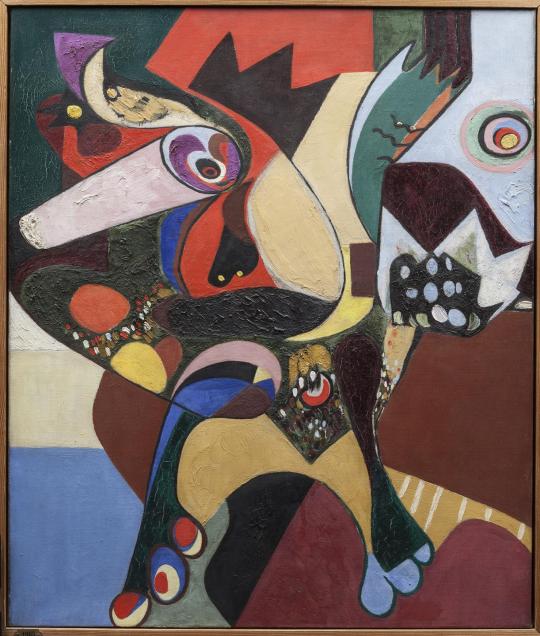
Danish painter, Ejler Bille (March 6, 1910 - 2004) was associated with several Danish and international artists’ groups throughout his long career, including Corner, Linien, CoBrA, Høstudstillingen 1938-50, and Den Frie Udstilling.
His art is inspired by mythologies and fantastic beings, for instance inspired by Balinese art and stories.
Above: Fugl/Bird, 1938 - oil on canvas (SMK)
#art#danish artist#ejler bille#1930s#primitivist art#balinese art#mythographic art#birds#smkmuseum#smk#statens museum for kunst#corner#linien#cobra#høstudstillingen#den frie udstilling#oil on canvas#fantastic art
5 notes
·
View notes
Text
youtube
Dennis Schmelz - Galungan - Victory of Dharma
This extraordinary short film shows a special take on the Ganungan holiday, the victory of dharma (good) over adharma (evil) and the time when the ancestral spirits visit the Earth.
You can see the Barong dance, telling the story of the fight between Barong and Rangda, which stands for the eternal battle between good and evil. In the mythological traditions Barong is the king of the spirits, leader of the hosts of good, and enemy of Rangda, the demon queen and mother of all spirit guarders.
Schmelz had the chance to shoot with traditional Balinese dancers. One of the precious traditional dances is Rejang, traditionally performed by young women, beautifully adorned with headdresses, in the inner courtyard of a temple. Rejang is also one of the holiest sacrificial dances to entertain the visiting gods and spirits.
Legong is another very common dance featured in the film. Telling the story of 13th century Java, it is a fast-paced dance with demanding movements and a cultural treasure of Bali.
2 notes
·
View notes
Text
The Splendors of Balinese Fine Art

The island of Bali, in Indonesia, is known for its stunning landscapes and wonderful culture. This is due in part to the rich history of art that has been created and preserved on the island. Balinese fine art is a unique form of art that is deeply rooted in the traditional Balinese culture. It has a unique style and uses a variety of mediums, including painting, sculpture, woodcarving, and more.
Balinese fine art is characterized by its bright colors, intricate designs, and spiritual themes. The art often depicts scenes from Balinese mythology, such as gods and goddesses, and scenes from everyday life. Balinese painting typically uses bright colors, such as red, yellow, and blue, to create beautiful and intricate designs. The paintings are usually made on canvas, but can also be made on wood, stone, or other materials.
Balinese sculpture is another popular form of art. These sculptures are made in a variety of styles, including traditional Balinese, modern, and abstract. The sculptures often depict Hindu gods and goddesses, animals, and scenes from everyday life. They are typically carved from wood, stone, or metal balinese fine art.
Woodcarving is another form of Balinese art. This art form is used to create furniture, sculptures, and other decorative items. Woodcarving is a very intricate and detailed art form, and it often takes years to master the craft. The woodcarving style is unique to each artist, and the artworks can be highly detailed and intricate.
Traditional Balinese music is also an important part of the culture. There are many different types of music, including gamelan, which is a type of traditional Balinese orchestra. The music is often played during religious ceremonies and celebrations.
Balinese fine art is not limited to painting, sculpture, and woodcarving. Many Balinese artists also create jewelry, tapestries, textiles, and other forms of art. These pieces often feature intricate designs and bright colors.
Balinese fine art is a beautiful and unique form of art. It is deeply rooted in the traditional Balinese culture and is a great way to explore the history and culture of the island. The art has a unique style and is created using a variety of mediums. From painting and sculpture to woodcarving and jewelry, Balinese art is truly a sight to behold.
4 notes
·
View notes
Text

Singha (2009)
The last of the older fantasy creatures that I drew in this time period is this Singha. It was created with colored pencils on July 26, 2009. The singha (Singa Bersayap) is a mythological creature that is found throughout southeast Asia, particularly in Thailand, Bali, and Indonesia. There they are often seen guarding the entrance to the temples. I believe they are also one of the Himmapan creatures of Thai mythology, although they usually don't have wings in the Thai version.
I based this drawing loosely off of a Balinese wood carved statue that I got many years ago.

Art Prints · Redbubble · Etsy · Facebook · Instagram
#rebecca wang#psychedelic zen#winged lion#fantasy art#art#artists on tumblr#traditional art#drawing#rainbow colors#colored pencil#singha#asian art#himmapan#rebeccawangart
3 notes
·
View notes